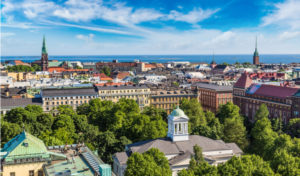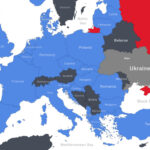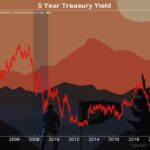
Helsinki , Finland. Image used under license from Shutterstock.com
I recently visited Helsinki and Russia along with Denmark and several unpleasant Baltic states. I did like Estonia. Despite having to negotiate a delicate balance with the Soviet Union to its south east, Finland survived the Cold War, and has emerged from the thaw as one of the stablest countries in Europe. As Simon Nixon notes in The Wall Street Journal, Finland is “one of the richest, most equal, most contented countries in the world.” He writes:
HELSINKI—This week’s 100th anniversary celebrations of Finland’s independence are partly a celebration of survival against the odds.
Even Lenin, who became the first world leader to recognize the country’s autonomy from Russia days after he seized power, didn’t expect it to last long; he calculated Finland would soon succumb to its own Bolshevik revolution and join the Soviet Union. But that revolution failed despite a bloody civil war, as did the Soviet attempt to annex Finland during World War II. Through cautious diplomacy, not least throughout the Cold War, Finland was able to survive and secure its place as a Western nation.
But the Dec. 6 anniversary is also a celebration of the country that Finns have built. Over the past 100 years, they have turned one of the poorest corners of Europe into one of the richest, most equal, most contented countries in the world. Finland consistently ranks near the top for education, innovation, political stability and quality of life. Its “Nordic model” based on robust institutions and a strong social safety net, has become a beacon for developing countries, particularly those seeking to rebuild after conflict.
This Nordic model emerged more by necessity than design, as Finns are the first to acknowledge. Finland’s famed egalitarianism can be traced to the need to heal rapidly the wounds of the civil war by accepting much of the Bolshevik agenda, especially in relation to land reform. Its postwar achievements in building an industrial base, providing high-quality education and a strong social safety net and promoting gender equality were driven largely by the need to mobilize all the country’s resources to pay war reparations to the Soviet Union.
Nor did Finland’s challenges end with the Cold War. It experienced a deep depression in the early 1990s following the collapse of the Soviet Union, then its major trading partner. More recently, a series of shocks caused the economy to shrink for four years between 2011 and 2015
Just as Finland’s survival in the last century owed much to its ability to adapt its Nordic model to new challenges, so it appears poised to do in the next.
Read more here.
What do Finns Think about the Finland 100 Years of Independence?
If you’re willing to fight for Main Street America, click here to sign up for my free weekly email.





